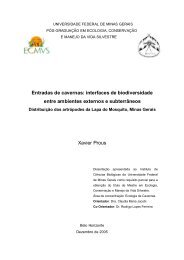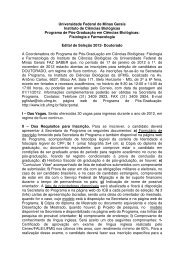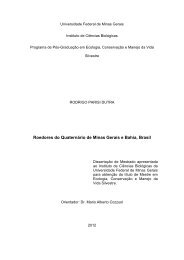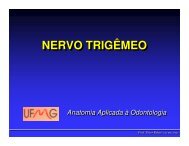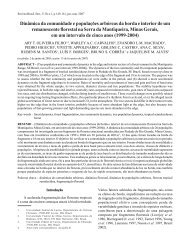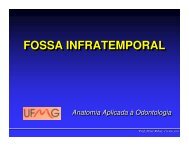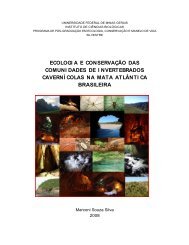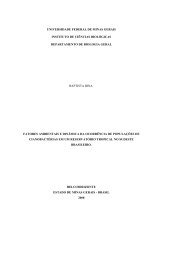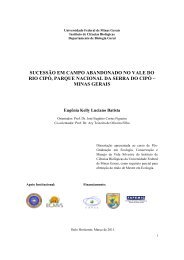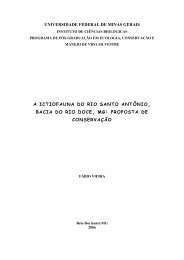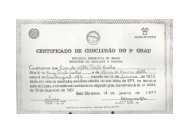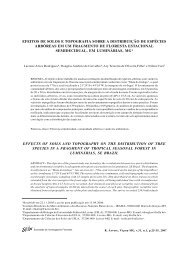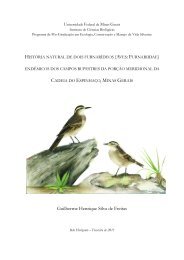Relatório 2005 Diversidade Faunística - ICB - UFMG
Relatório 2005 Diversidade Faunística - ICB - UFMG
Relatório 2005 Diversidade Faunística - ICB - UFMG
Create successful ePaper yourself
Turn your PDF publications into a flip-book with our unique Google optimized e-Paper software.
387<br />
SAMSON, P.R. 2002. Field response of sugarcane cultivars to sugarcane soldier fly,<br />
Inopus rubriceps (Macquart) (Diptera:Stratiomyidae). Australian J. of<br />
Entomology 41: 262-266.<br />
SCHUCHMANN, K.L. 1996. Hummingbirds – Ecophysiological and behavioral<br />
adaptations to extreme environmental conditions and to limited food sources:<br />
a review. Anais – V Congresso brasileiro de Ornitologia- Unicamp. Pp 67-76.<br />
SEIFERT, R. P. 1980. Mosquito fauna of Heliconia aurea. Journal of Animal Ecology<br />
49: 687-697<br />
SEIFERT, R. P.; BARRERA, R. 1981. Cohort studies on mosquito (Díptera: Culicidae)<br />
larvae living in the water-filled floral bracts of Heliconia aurea (Zingiberales:<br />
Musaceae) Ecological Entomology 6: 191-197<br />
SEIFERT, R.P. & SEIFERT, F.H. 1976. A community matrix analysis of Heliconia<br />
insect communities. The American Naturalist, 110: 461-483.<br />
SEIFERT, R.P. & SEIFERT, F.H. 1979a. A Heliconia insect community in a<br />
Venezuelan cloud forest. Ecology, 60(3): 462-467.<br />
SEIFERT, R.P. & SEIFERT, F.H. 1979b. Utilization of Heliconia (Musaceae) by the<br />
beetle Xenarescus monocerus (Oliver) (Crysomelidae: Hispinae) in a Venezuelan<br />
Forest. Biotropica, 11(1): 51-59.<br />
SHEPPARD, C. 2002. Black soldier fly and others for value-added manure<br />
management. http://www.virtualcentre.org/en/enl/vol1n2/article/ibs_conf.pdf<br />
(acessado em 21/02/2006).<br />
SOCT – Sistema Operacional de Ciência e Tecnologia. 1981. Fundação Centro<br />
Tecnológico de Minas Gerais – CETEC. Programa de pesquisas ecológicas do<br />
Parque Estadual do Rio Doce. Belo Horizonte v.2.<br />
SOKAL, R.R. & ROULF, F.J. 1995. Biometry 3 a ed. W.H. Freeman and Co., New<br />
York.<br />
SOMMAGGIO, Daniele. 1999. Syrphidae: Can they be used as environmental<br />
bioindicators? Agriculture, Ecosystems and Environment. 74: 343 – 356.<br />
SOUZA, A. M.; TEIXEIRA, F. P.; RIBEIRO, I. R.; PENA, L. M.; OLIVEIRA, M. D.<br />
& LOMÔNACO, C. 1990. R. Cent. Ci. Bioméd. Univ. Fed. Uberlândia 6(1): 9-<br />
14.<br />
SOUZA-SILVA, M., FONTENELLE, J.C.R. & MARTINS, R.P. 2001. Seasonal<br />
abundance and species composition of flower-visiting flies. Neotropical<br />
Entomology. 30(3): 351-359<br />
SSYMANK, A. & GILBERT, F. 1993. Anemophilous pollen in the diet of Syrphid flies<br />
with special reference to the leaf feeding strategy occurring in Xylotini. Dtsch.<br />
Entomol. Soc. 40(2): 245-258.<br />
STEPHENS, C.S. 1975. Hermetia illucens (Diptera Stratiomyidae) as a banana pest in<br />
Panama. Tropical Agriculture 52: 173-178.<br />
STILES, F.G 1975. Ecology, flowering phenology, and hummingbird pollination of<br />
some Costa Rica Heliconia species. Ecology 56:285-301.<br />
STILES, F.G. & FREEMAN, C.E., 1993. Patterns in floral nectar characteristics of<br />
some bird-visited plant species from Costa Rica. Biotropica 25(2):191-205.



